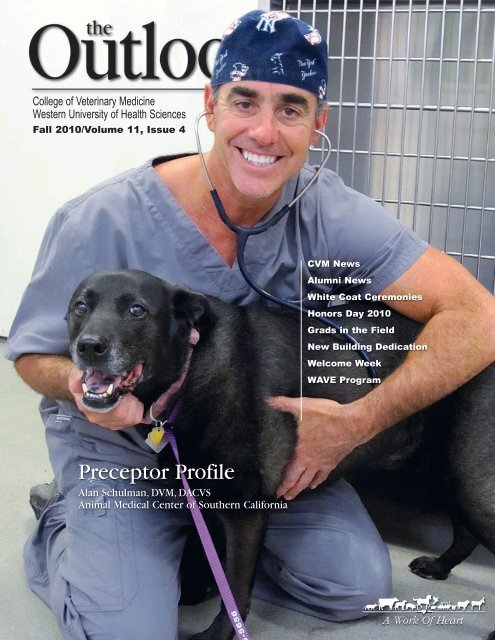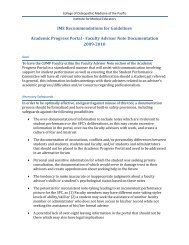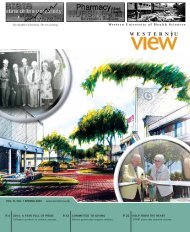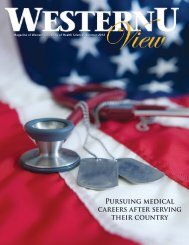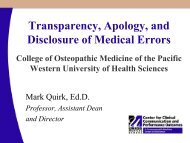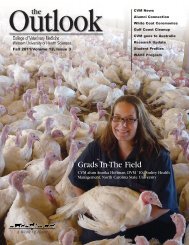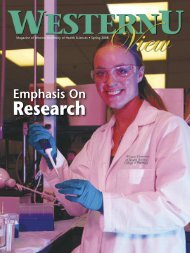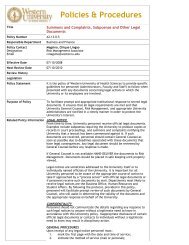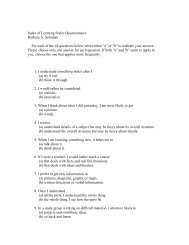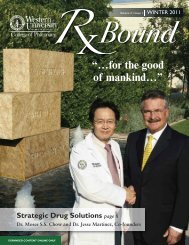Preceptor Profile - Western University of Health Sciences
Preceptor Profile - Western University of Health Sciences
Preceptor Profile - Western University of Health Sciences
- No tags were found...
You also want an ePaper? Increase the reach of your titles
YUMPU automatically turns print PDFs into web optimized ePapers that Google loves.
C V M C a l e n d a rVeterinary Board Exam Prep ..........................................................November 1, 2, and 3, 2010Job Fair .................................................................................................November 4 and 5, 2010A Tribute to Caring (www.westernu.edu/tribute)................................................November 13, 2010National Board Exam ........................................................November 15 to December 11, 2010Thanksgiving Break ............................................................................November 25 to 26, 2010Winter Break.................................................................December 20, 2010 to January 3, 2011Open House .............................................................................................................April 2, 2011Honors Day.............................................................................................................................TBASpring Break ................................................................................................March 21 – 25, 2011CAREs ..........................................................................................................March 23 – 25, 2011♥2 0 0 7 C V M C h a r t e r C l a s sA l u m n i C a l e n d a r♥Class <strong>of</strong> 2007 Five Year Reunion.........................................................................................2012Alumni <strong>Western</strong> States meeting, Las Vegas, Nev. ...............................................................TBA3
White Coat CeremonyWelcomes Class <strong>of</strong> 2014MEMBERS OF THE WESTERNU COLLEGE OF VETERINARY MEDICINE Class <strong>of</strong>2014 took their first steps toward a veterinary degree on Aug. 7 duringthe traditional White Coat ceremony. The event, at Bridges Hall <strong>of</strong> Music inClaremont, followed the Convocation the same day at Ontario ConventionCenter.CVM Dean Phillip Nelson, DVM, PhD, welcomed the assembled faculty,students, family and friends. In his greeting, Vincent J. Naimoli <strong>of</strong> Tampa,Fla., a member <strong>of</strong> the <strong>Western</strong>U Board <strong>of</strong> Trustees and father <strong>of</strong> a CVMstudent, extolled the 105 members <strong>of</strong> the new class to “do good things”with their veterinary degrees.Keynote speaker Clinton A. Lewis Jr., president <strong>of</strong> U.S. Operations forPfizer Animal <strong>Health</strong>, praised the education the studentswere about to receive. He stressed that it takes theright faculty, aswell as therightteachingand learningapproach, forsuccess and thenew class “will join along list <strong>of</strong> veterinarians who havebenefited” from <strong>Western</strong>U. He saidthe <strong>Western</strong>U model <strong>of</strong> problembasedlearning and the teamapproach should be the approach forteaching everywhere.“You have a distinct advantage,” hetold the students.As for practical advice, he <strong>of</strong>fered alist that included:• Place value on communicationand business skills as well asthe clinical aspects.• Learn from the faculty. Talkwith them, explore with them.• Be flexible to new and different career opportunities. Consideremerging markets such as China, Asia and Eastern Europe.• Consider all options beyond private practice, such as food security,bioterrorism, and research.“The white coats symbolize an important step in yourjourney,” Mr. Lewis said.He added that the new class is “extraordinarilyprivileged to attend this wonderful, forward-thinkinguniversity.”Dean Nelson followed up Mr. Lewis’ speech bypresenting him with a plaque honoring his longstandingcommitment and support to veterinary medicine.The students were presented by Associate Dean <strong>of</strong> Academic Affairs,Teresa Morishita, DVM, PhD, and Josep Rutllant, DVM PhD, Director <strong>of</strong>Second Year Curriculum. Director <strong>of</strong> First Year Curriculum, John Tegzes,MA, VMD, DABVT, administered the Pledge <strong>of</strong> Commitment, whileAssociate Dean <strong>of</strong> Faculty Affairs, Stephen Waldhalm, PhD, DVM, led thefaculty in the Veterinarian’s Oath.In closing, Dean Nelson told the class, “The white coat represents asymbol <strong>of</strong> trust. There are people who will depend on you.”4
Shining STARS <strong>of</strong> Summer★★SEVENTEEN STUDENTS PRESENTED AN ARRAY OF SUMMER RESEARCH PROJECTS inthe CVM portion <strong>of</strong> <strong>Western</strong> <strong>University</strong> <strong>of</strong> <strong>Health</strong> <strong>Sciences</strong>’ Third AnnualStudent Technology and Research Symposium – STARS. The daylong eventon July 27 featured presentations on subjects as wide ranging aspedigrees <strong>of</strong> snow leopard and seal histology to canine ehrlichiosis in thehighlands <strong>of</strong> Peru.As part <strong>of</strong> the program, participating students wrote an abstract on theirresearch, then gave a 15-minute oral presentation and answered questionsfrom faculty, fellow students and visitors.Tom Phillips, DVM, PhD, who oversees the program, praised the projectsand presenters, noting this was the third year the event has been held. “Itstarted out as a college-sponsored event, but the last two years, due to itssuccess, it has been a university-wide event. Each year the quality <strong>of</strong>presentations, the data, and the research have improved over the previousyear’s entries.”★Dr. Phillips also lauded the benefits <strong>of</strong> the program itself. “The summerstudent research program is important, as it gives students, in a clinicaldegree program, a ‘taste’ <strong>of</strong> research. The STARS acronym really says it all,for participating students have the potential to become stars <strong>of</strong> thepr<strong>of</strong>ession – to contribute knowledge and understanding to the science<strong>of</strong> medicine, and to make new discoveries that will benefit human andanimal health. The students gain a better appreciation <strong>of</strong> research and theeffort needed to succeed in this field. This greater understanding will helpthem become better veterinary pr<strong>of</strong>essionals, no matter what career paththey choose. Research is the underpinning <strong>of</strong> our current understanding<strong>of</strong> medicine and will be the source <strong>of</strong> future advancements. Byparticipating in this program, they are better positioned to determine thevalidity <strong>of</strong> new information and what changes, if any, should be made toveterinary practice. For those who consider a research career path aftergraduation, this early exposure will inform this important decision. We areproud <strong>of</strong> these students, for choosing to spend their summer in thepursuit <strong>of</strong> new knowledge.”Dr. Phillips said special thanks should go to the sponsors <strong>of</strong> the studentsummer research stipends: Merial, Morris Animal Foundation, <strong>Western</strong>U’sSummer Student Research Grants, and CVM Summer Student ResearchGrants.Even though many <strong>of</strong> the students were nervous and had trepidationsabout presenting their results at STARS, a post-seminar survey revealedthat 92 percent <strong>of</strong> responding students (response rate, 64 percent)enjoyed the STARS symposium. And although awards wereonly given to four students, all the presentations were <strong>of</strong> an exceptionallyhigh quality, which made the selection process difficult, according toDr. Phillips.★★★★ ★ ★ This year, the following students participated in the CVM STARS program: ★ ★ ★Bradley Ahrens, mentored by Dr. Carlos CockerBacterial etiology <strong>of</strong> necrotic arachnidism in black widow spider bitesSuzanne Benedict, mentored by Dr. Linda KiddPersistent hyperadrenocorticism in dogs with pituitary-dependent hyperadrenocorticism on trilostane therapyAleli Camacho, mentored by Dr. Kristopher IrizarryComparative analysis <strong>of</strong> gene expression in skin under pathologic conditionsJanet Cometa, mentored by Dr. Janis JoslinA study on the incidence <strong>of</strong> various diseases in captive snow leopards in North AmericaCharli Dong, mentored by Dr. Peggy BarrSnow leopard pedigreeSonia Fang, mentored by Dr. Wael KhamasHistomorphology and functional correlates <strong>of</strong> the vasculature in the female reproductive tract <strong>of</strong> northernelephant seals and California sea lionsErica Faulhaber, mentored by Dr. Kristopher Irizarry and Dr. Katherine Mitsouras from COMPGene amplification and analysis <strong>of</strong> snow leopard papillomavirusEric. J. Fish, mentored by Drs. Pedro Paulo Diniz, Frank Bossong,Ellen Collisson and Yvonne DrechslermRNA detection and genomic analysis <strong>of</strong> feline coronavirus in monocytes <strong>of</strong> healthy shelter catsin Southern CaliforniaGordon Hui, mentored by Dr. Kristopher IrizarryConstruction <strong>of</strong> host and papilloma viral protein interaction map to facilitate understanding<strong>of</strong> papillomavirus genomeKimberly Lin, mentored by Dr. Hrvoje SmodlakaSeal histologyLisa Lippman, mentored by Dr. Yvonne DrechslerIsolation and cloning <strong>of</strong> an avian coronavirusBridget Morton, mentored by Dr. Pedro Paulo DinizDetection <strong>of</strong> an intracellular pathogen by direct PCR from blood samplesBridget Morton, mentored by Dr. Pedro Paulo DinizCanine ehrlichiosis in the Highlands <strong>of</strong> PeruSean Perry, mentored by Dr. Pamela GovettComparing MS-222 (tricaine methanesulfonate) and prop<strong>of</strong>ol’s influenceon acid-base status in elasmobranches during anesthesiaLindsey Porterfield, mentored by Dr. Josep RutllantThe use <strong>of</strong> canine testicles as a model to retrieve viable epididymal spermatozoafrom related endangered speciesKursten Roderick, mentored by Dr. Jennifer BuurPharmacokinetics <strong>of</strong> N-acetylcysteine in healthy catsStephanie Rodriguez, mentored by Dr. Maria Pia PhillipsComparison <strong>of</strong> glutathione and liposomal glutathione on the levels <strong>of</strong> oxidativestress in FIV-infected astrocytesJennifer Scudder, mentored by Dr. Katherine Mitsouras from COMPand Dr. Kristopher IrizarryThe use <strong>of</strong> trait mapping to evaluate differences in phenotype and geneticvariation between bullmastiff littermates★ ★ ★This year awards were given to:Best Presentation (tie): Lisa Lippman and and Stephanie RodriguezMost Research Progress: Eric FishMost Potential for a High Impact Publication: Jennifer ScudderMost Daring Research: Bradley Ahrens5
PRECEPTOR PROFILEAT ANIMAL MEDICAL CENTER OF SOUTHERN CALIFORNIA, students from <strong>Western</strong>U’s College <strong>of</strong> VeterinaryMedicine receive a good deal <strong>of</strong> hands-on training – literally – under Dr. Alan Schulman, DVM,Diplomate <strong>of</strong> the American College <strong>of</strong> Veterinary Surgeons.“I want them to get used to doing a full exam on every animal,” he explains. “In addition, when wehave a normal dog, I want the students to feel the elbows, shoulders, hips and knees – I wantthem to get used to seeing and feeling what a normal dog feels like.”It is through these procedures that Dr. Schulman hopes to help instill confidence in the studentswho rotate through his practice. “We end up saying to the students that we know they haveexcellent didactic training, now I really want them to get the experiences that will make themfeel that much better about their abilities. I want them to feel good about handling animals anddoing surgical procedures.”At Animal Medical Center, located in Los Angeles, students in rotations may see a variety <strong>of</strong> cases.“The practice is a full-service, 24/7 emergency referral center and general practice,” Dr. Schulmanexplains. “We see a phenomenal cross section <strong>of</strong> cases – anything from the normal to all <strong>of</strong> the exoticspecialties that come in the door.”One to two students at a time spend four weeks in rotation with Dr. Schulman and his staff. “Myexpectations have been met by each and every student who passes through here,” he says.“<strong>Western</strong>U students really do measure up. They seem well rounded, have a great attitude andgood surgical and tissue handling abilities.” And, he stresses, “they want to learn. They askbrilliant questions and are very receptive. They have received excellent trainingcomparable to some <strong>of</strong> the more established veterinary training facilities inthe U.S.”Dr. Schulman says serving as a preceptor has been beneficial tohim “because sometimes I forget the breadth <strong>of</strong> knowledge after27 years and take some things for granted. It’s great to be able toshare that knowledge.”His own interest in veterinary medicine developed when he wasa child, growing up in New York City. “I knew I wanted to be aveterinarian from the time I was a munchkin,” he relates. Hisparents were extremely supportive, and he reveled in summersin the Catskill Mountains <strong>of</strong> upstate New York where he learnedabout critters such as frogs, salamanders and snakes.He went on to earn his undergraduate degree from The College<strong>of</strong> Agriculture and Life <strong>Sciences</strong> at Cornell <strong>University</strong>, followed bya DVM from The New York State College <strong>of</strong> Veterinary Medicine,also at Cornell. He completed an internship and surgicalresidency at California Animal Hospital in Los Angeles and set uphis own practice in 1989.In addition to his work as a veterinarian, Dr. Schulman also is afrequent, well-known guest expert on local and national newsand information programs. In his spare time, he likes to ride hishorse, ski, and work out, train and play with the New YorkYankees during the <strong>of</strong>f season as well as many National HockeyLeague players.Dr. Schulman hopes that students who rotate through hispractice will “get the experience that will make them the bestdoctors.” In addition, he <strong>of</strong>fers this advice: “Be patient and be ableto communicate with people. Never really forget thatcommunication is one <strong>of</strong> the important things to do as a vet.And, never be complacent, because when you’re complacent,you’re standing still, but you’re not really standing still, you’refalling behind. Keep up with new advancements anddevelopments.”6
<strong>University</strong> DedicatesNew BuildingsWESTERN UNIVERSITY OF HEALTH SCIENCES dedicated its twonewest buildings – the <strong>Health</strong> Education Center and thePatient Care Center – in late August during a ceremonyattended by university, state and U.S. dignitaries. California State<strong>University</strong> Chancellor Charles B. Reed, EdD, served as thekeynote speaker, noting that <strong>Western</strong>U is addressing California'sdire need for more health care workers thanks to visionaryleadership.“The role <strong>of</strong> all universities, public and private, is to preparestudents to meet the future needs <strong>of</strong> our businesses andcommunities and families, and in doing so, universities need tobe fully integrated in their communities,” Chancellor Reed said.At <strong>Western</strong>U, “community service has been a cornerstone <strong>of</strong>this university’s philosophy since it was first established morethan 30 years ago. Today’s dedication represents another newchapter in the expansion<strong>of</strong> <strong>Western</strong>U’s efforts tomeet the needs <strong>of</strong> somany Californians.”He praised <strong>Western</strong>UFounding President PhilipPumerantz for his longtermvision and forcontinuing to propel the<strong>University</strong> to new andgreater heights.“He also deserves credit for developing a real sense <strong>of</strong> familyand community” at <strong>Western</strong>U, the chancellor said during theAug. 25 event. “The personal experience that students havehere translates into the kind <strong>of</strong> experience that they can givetheir patients. And that is an incredibly important contributionto our society and to our state.”He also acknowledged thecontributions <strong>of</strong> <strong>Western</strong>UProvost and COO BenjaminCohen, Assistant Provost forStrategic Operations andClinical Services Joan Sandell,Executive Director <strong>of</strong>Facilities and Physical PlantTodd Clark and <strong>Western</strong>Uboard member Vince Naimoli.In addition, Dr. Pumerantzthanked the Board <strong>of</strong> Trustees for its support and Senior VicePresident for Advancement Thomas Fox for organizing thededication ceremony.Representatives from the <strong>of</strong>fices <strong>of</strong> Assemblywoman NormaTorres, U.S. Rep. Grace Napolitano and state Sen. Gloria NegreteMcLeod presented Dr. Pumerantz with proclamations. PomonaChamber <strong>of</strong> Commerce Executive Director Frank Garcia andmembers <strong>of</strong> the Pomona City Council presided over a ribboncuttingceremony.7
OrientationA Team Effort at CVMTHERE WERE ACTIVITIES (NOT GAMES). There were lectures andlearning to trust each other. There was the consideration <strong>of</strong> aparadigm shift in how they view their pr<strong>of</strong>ession.For the 100-plusfirst-year studentsand a handful <strong>of</strong>faculty from the<strong>Western</strong>U College <strong>of</strong>Veterinary Medicinewho participated,this was all part <strong>of</strong> ateam building andorientation programon campus prior tothe start <strong>of</strong> classes inAugust.The two-day event at <strong>Western</strong>U was based on the curriculum<strong>of</strong> the national AVMA Veterinary Leadership Experience (VLE),a five-day program put on each summer in Post Falls, Idaho,according to Betsy Charles, DVM, MA, who helped facilitate theCVM course.“The whole premise is that in order to be effectiveveterinarians or medical doctors or teachers, you need to beemotionally intelligent,” explains Dr. Charles. “And we believethe most effective way to lead is through servant leadership.The VLE curriculum is built on those ideas as are theorientation programs we provide.”After the variouscomponents werecompleted, the participantswere debriefed. “Wewanted to know ‘What didyou learn from this? Whathappened? How will youapply this to a veterinarypractice?’ ”Dr. Charles says this wasthe second year theprogram has been <strong>of</strong>feredat <strong>Western</strong>U and feedbackwas extremely positive. “Many felt it gives them a skill set to beable to manage a difficult pr<strong>of</strong>essional curriculum … Usuallythey are very skeptical at the beginning, but then they see howit works and get excited about it.”A part-time instructor in the CVM and a radiology resident, Dr.Charles was asked to head up the team-building event because<strong>of</strong> her background. She has a Master’s degree in organizationalleadership and is a member <strong>of</strong> the core leadership team for theAVMA VLE.She says the program has one key goal: “This is all abouthelping the students to become compassionate and caringhealth care providers.”Students were welcomed to campus for the 2010-2011 school year in August with a round <strong>of</strong>activities and special events. Among the highlights were university orientation, a lunch sponsoredby Novartis, sessions on problem-based learning, and a roundtable featuring “Students’ Secrets toSuccess.” Parent’s Night capped the day on Aug. 6.The final day, Aug. 7, began with <strong>University</strong> Convocation at Ontario Convention Center, followed bythe College <strong>of</strong> Veterinary Medicine’s White Coat Ceremony at Bridges Hall <strong>of</strong> Music in Claremont.The festivities concluded with the President’s Picnic at Ethan Allen Park on the <strong>Western</strong>U campus.8
A Beneficial PartnershipCVM Teams Up with Claremont Organization to Aid SeniorsRVT LuAnn Manley holds Vinny in the VACS unit,which is providing free basic pet care to seniors inClaremont.SENIORS IN CLAREMONTARE BENEFITING from theknowledge <strong>of</strong> studentsand faculty at<strong>Western</strong>U’s College <strong>of</strong>Veterinary Medicinethrough the VeterinaryAmbulatory CommunityService Program (VACS).The program, which is<strong>of</strong>fering free basicveterinary care to thecity’s seniors for alimited time, is madepossible through a$9,800 grant from theClaremont CommunityFoundation, accordingto CVM’s Frank Bossong,DVM, Assistant Pr<strong>of</strong>essor<strong>of</strong> shelter medicine.The program got underway on Tuesday,Sept. 28, 2010, when themobile VACS unit pulled up to the Joslyn Senior Center. Abouttwo dozen seniors turned out with cats and dogs, and duringthe day, three neutering surgeries were performed, accordingto Eva Jaeger, RVT at the CVM, whowas part <strong>of</strong> the VACS team. Theother RVT at the event was LuAnnManley.During the visit, each senior wasinterviewed by veterinary studentsand faculty to collect a thoroughhistory <strong>of</strong> their pets. Proceduresavailable included exams, spaying,neutering, pre-screening bloodwork, vaccines, micro chipping,heartworm testing and FeLV-FIVtesting. Veterinary students andfaculty explained the proceduresplanned and performed andanswered seniors’ questions.“Our goal for the students is for them to really get the concept<strong>of</strong> community service – the importance <strong>of</strong> giving back to thecommunity,” Dr. Bossong said prior to the inaugural outreachevent. “Plus, they get really hands-on training in a situation likethis so they are practice ready.”Dr. Frank Bossong, assistant pr<strong>of</strong>essor in shelter medicine, shows CVMstudents how to tell the age <strong>of</strong> a dog by looking at its teeth during the VACSunit’s stay at the Joslyn Senior Center on Sept. 28.First-year CVM students Lindsay Smith, Nicole Wyatt and Yvonne Rosales look overa Chihuahua as part <strong>of</strong> the VACS program.After the Sept. 28 session, Dr. Bossong noted that it “had a greatturnout and seniors were anxious to know when we werescheduling the next event. LuAnn Manley noted that we saw21 patients that day and several had never been to theveterinarian before and needed care. So, we feel the day was abig success.”Another VACS day is planned at the Joslyn Center in thecoming months.Nickia Cleaves, executive director <strong>of</strong> the ClaremontCommunity Foundation, said the program money was a giftfrom Dr. Cynthia Gordon <strong>of</strong>Claremont, who requested it beused “for the care <strong>of</strong> companionanimals for people <strong>of</strong> restrictedmeans.” “We looked at differentoptions and when we heard aboutthe <strong>Western</strong>U mobile unit thatseemed like a wonderful thing tosupport,” she explained.The overall mission and goal <strong>of</strong>the VACS program is to <strong>of</strong>fer basicveterinary care to underservedanimal populations and thepeople who care for them. VACS isdedicated to increasing successfulpet-family relationships andreducing homeless animalpopulations through education and care. This service-learninginitiative promotes veterinary student learning about medicine,societal issues and community service through active civicengagement and outreach.9
C V M S t u d e n t P r o f i l e s - C l a s s o f 2 0 1 4♥Ann-Marie AumannRaised in Bedford, Mass., I graduated with a BAin Economics from Calvin College in GrandRapids, Mich. As an avid equestrian, with mycentral veterinary interest in equine sportsmedicine, I look forward to starting at <strong>Western</strong>Uin Southern California – a geographic hotbed <strong>of</strong>horse activity!Kendra Bettis-ScheibeI grew up in Golden, Colo., and received myBachelor's degree in Biology from the<strong>University</strong> <strong>of</strong> California, San Diego. I workedfor a small animal practice in San Diego andI volunteered for Rescue House, a cat rescueand adoption organization. I am interestedin small animal medicine.I was raised in Southern California and received myBachelor’s degree from California State <strong>University</strong>,Long Beach in Microbiology with minors inChemistry, Computer Science, and Anthropology.I’ve worked with domestic, exotic, and marineanimals. I enjoy playing capoeira and all watersports, especially outrigger paddling and surfing.Ryneil CastroI am from Santa Fe, Texas, a small townjust outside <strong>of</strong> Galveston. I received myBachelor’s from Texas A&M <strong>University</strong>with a major in Animal Science. I havespent the past five years working at aspecialty hospital in Houston, Texas. Myinterest is in small animal emergencyand critical care medicine.Jeannie ClarkKimberly DanaherI was born and raised in Brooklyn, N.Y., andgraduated from Manhattan College in theBronx with a BS in Biology. My experienceincludes volunteering at a small animalclinic and a stable, and research inpaleontology. I am primarily interested insmall animal and wildlife medicine.Michelle CrupiI grew up in Derry, N.H., and received myBachelor’s degree in Pre-Veterinary Medicinefrom the <strong>University</strong> <strong>of</strong> New Hampshire.I worked for a mixed animal practice as anundergraduate, and I volunteered at a wildliferehabilitation sanctuary in Africa in June, 2009.I am interested in mixed animal medicine.Originally from Sturbridge, Mass., I receivedmy Bachelor’s degree in both Biology andSpanish from Drew <strong>University</strong> in Madison,N.J. My undergraduate research studied wildsmall mammals and deer, and I volunteeredat a wildlife clinic at Tufts <strong>University</strong>. I aminterested in wildlife medicine.Ian DeStefanoI grew up in Philadelphia, Pa., and receivedmy BS in Bioengineering from Syracuse<strong>University</strong> in 2010. I am very interested inpursuing small-animal orthopedic surgery, butam also going into <strong>Western</strong>U with an openmind. I’m really excited to try a little bit <strong>of</strong>everything and see where my passion lies.Christine DePompeoJanelle DumlaoI grew up in San Jose, Calif., and attended<strong>University</strong> <strong>of</strong> California, Davis for myundergraduate studies in Animal Science. I aminterested in all fields <strong>of</strong> veterinary medicineand am eager to learn all about my futurepatients. Here’s to an exciting and challengingjourney in veterinary medicine!Elizabeth FerderbarI grew up in Menomonee Falls, Wis., andreceived my Bachelor’s degree in AnimalScience from the <strong>University</strong> <strong>of</strong> Minnesota.I volunteered in Australia with exotics,interned at a cat and dog practice, andinterned at a raptor rehabilitation facility.I hope to practice exotic and companionanimal medicine.10
C V M S t u d e n t P r o f i l e s - C l a s s o f 2 0 1 4♥Marissa HeilI am interested in the behavior <strong>of</strong> all kinds<strong>of</strong> animals, including zoo, wildlife, and smallanimals. I completed my Bachelor’s degree atthe <strong>University</strong> <strong>of</strong> California, Davis, majoringin Animal Science with an emphasis onBehavior. I grew up all over but lived most <strong>of</strong>my life in Orange County, Calif.I was born and raised in South Korea and movedto Charlotte, N.C., when I was 14. I received myBS and MS in Biology from the <strong>University</strong> <strong>of</strong>North Carolina, Charlotte. I am hopeful thatmany years <strong>of</strong> small animal experience andscientific research will contribute to mybecoming a successful veterinarian.Hye-Young (Erica) KimI grew up in New Jersey and graduatedfrom Rutgers <strong>University</strong>. I majored inAnimal Science, minored in the Biological<strong>Sciences</strong>. I was a research assistant atschool, worked as a veterinary technicianat a small animal clinic, and volunteered asa veterinary assistant at an equine practice.Bryan LuiI grew up in the foggy, but beautiful town <strong>of</strong>Tiburon, Calif. I received my Bachelor’sdegree in Animal Science from CaliforniaPolytechnic State <strong>University</strong>, San LuisObispo. I worked for a small animal practiceand I assisted with elephant conservationresearch in Africa. I am interested in smallanimal medicine, especially surgery.Nicole MalecekAngelo MarcoI grew up in Southern California and receiveda BS in Human Biology from the <strong>University</strong> <strong>of</strong>California, San Diego. I have worked in smallanimal medicine since 2001 and as an RVTsince 2009. My interests are in radiology,genetics, and theriogenology. I can’t wait tostart this most exciting journey!Elise McDevittOriginally from New Hampshire, I received myBachelor’s degree in Biochemistry fromWorcester Polytechnic Institute in Massachusettsand completed my senior qualifying project inembryology at the <strong>University</strong> <strong>of</strong> MassachusettsMedical School. For the past two years I havebeen working for a contract researchorganization in pre-clinical drug testing.I was born and raised in Tucson, Ariz.I graduated from the <strong>University</strong> <strong>of</strong>Arizona with a BS in Veterinary Science.I worked in a small animal practice andhave volunteered with livestock, horses,and wildlife. I am primarily interested insmall and large animal medicine.Cynthia McGroganFollowing a successful business career, I wasinspired to pursue veterinary medicine whilevolunteering at a wildlife rescue facility inNorthern California. I’ve worked in a shelterand with equine facilities and a farm animalsanctuary. I am interested in becoming a ruralmobile vet and continuing my volunteer efforts.Sue MowattCaitlyn NealI graduated from Penn State <strong>University</strong>,double majoring in Animal BioScience andPsychology, and double minoring in EquineScience and International Agriculture. Mycurrent interests lie in the field <strong>of</strong>pathology and shelter medicine but I guesswe’ll see where the next four years lead.Amanda PinderI grew up in Nassau, Bahamas, and justrecently graduated from the <strong>University</strong> <strong>of</strong>Florida with a Bachelor’s degree in AnimalScience with an emphasis in animalbiology. I have interned at a variety <strong>of</strong>places including a dolphin encounterfacility back in The Bahamas.11
C V M S t u d e n t P r o f i l e s - C l a s s o f 2 0 1 4♥I grew up on the west coast <strong>of</strong> France. Imoved to Los Angeles 10 years ago where Iwent back to school. I followed the RVTprogram at Pierce College then completed theprerequisites for veterinary school. I workedwith large and small animals, wildlife, and wastrained in laboratory animals.Maritchu Ravenscr<strong>of</strong>tYvonne RosalesI was born and raised in Fontana, Calif., andreceived my BS in Animal Science with aminor in Microbiology from California StatePolytechnic <strong>University</strong>, Pomona. I work reliefat an emergency clinic in Upland, Calif., andwork at a day practice in Corona, Calif. I aminterested in laboratory animal medicine.I grew up in Palmdale, Calif. I receivedmy Bachelor’s degree in Animal Sciencefrom the <strong>University</strong> <strong>of</strong> California, Davis. Ihave worked in a small animal clinic anddid an internship at the UC DavisVeterinary Medical Teaching Hospital inlarge animal radiology. I would like t<strong>of</strong>ocus on exotic animals.John RuitenbachI’m from Colorado Springs, Colo., andreceived my BS in Organismic Biology from<strong>University</strong> <strong>of</strong> Colorado, Colorado Springs. Iworked at a small animal-exotics-wildlifeclinic during undergrad, and also spent timedoing schutzhund training. I am interested insmall animal medicine.Karin SelbyKara SeylerBorn and raised in Southern California, Iobtained my BS in Biology from the<strong>University</strong> <strong>of</strong> California, Los Angeles. Ihave worked in small animal privatepractice for a little over a year, and amexcited to explore other areas <strong>of</strong>veterinary medicine at <strong>Western</strong>U.Ryan SittonI was born and raised in central Arizona.In the fall <strong>of</strong> 2009 I received my BS inAnimal Physiology from Arizona State<strong>University</strong>. I enjoy camping, fishing andspending time on our family cattle ranch.I am the proud father <strong>of</strong> two youngdaughters. I am interested in food animalmedicine.Born in the Philippines, I grew up in SouthernCalifornia and graduated from the <strong>University</strong><strong>of</strong> California, Irvine in 2009 with a degree inBiology. I am interested in laboratory and smallanimal medicine, specializing in oncology.I have three dogs: Duke, Venus, and Gale, all <strong>of</strong>whom live with my family in Texas.Stanley SowyI’m from a small town in New Hampshireand graduated from the <strong>University</strong> <strong>of</strong> NewEngland, where I majored in MedicalBiology and minored in Chemistry. Myundergraduate summers were spentworking at a mixed animal practice and Ivolunteered at a marine animalrehabilitation center while at school.Amanda WhiteKendall WilsonI grew up in Maryland and graduated fromCornell <strong>University</strong> with a BS in AnimalScience. While in college I worked in smallanimal medicine and research, and aftergraduating in 2008 I worked in healthcaremarket research in New York City. I amexcited to decide my career focus at<strong>Western</strong>U!Josh YonasI am from Pittsburgh, Pa. I earned my BS inBiology from Dickinson College and afterworking as a marine mammal observer, Imoved to San Diego for my master’s. Iearned my MS from San Diego State<strong>University</strong> in Evolutionary Biology studyingwalruses. My interests are marine mammaland small animal medicine.12
C V M F a c u l t y U p d a t eRONALD L. TERRA, DVM, MS,MBA, has been named Director<strong>of</strong> Fourth Year Curriculum. Hesucceeds Peggy Schmidt, DVM,MS, DACVPM, who moved to thenewly created position <strong>of</strong>Director <strong>of</strong> OutcomesAssessment.“I am looking forward to doing asgood a job as Dr. Schmidt,” hesays. “I hope to make fourth yearas enjoyable as possible whileenabling the students to learn asmuch as they possibly can toRONALD TERRA succeed.”Now in his fifth year at <strong>Western</strong>U,Dr. Terra has been the course leader for clinical skills for the pastfour years. His background is in food animal medicine, for whichhe developed an interest working on his grandfather’s dairy farmin the tiny northern California town <strong>of</strong> Winton.He pursued animal science further at the <strong>University</strong> <strong>of</strong> California,Davis, obtaining an undergraduate degree in 1977 while also amember <strong>of</strong> the football and track teams for four years. In 1982, heearned both a DVM and an MS in Animal Science, both also fromUC Davis. He received his MBA in Agriculture from the <strong>University</strong><strong>of</strong> Guelph in Ontario, Canada, in 2002.His pr<strong>of</strong>essional career led him to Turlock, Calif., and the LanderVeterinary Clinic, where he practiced for 24 years. During hisspare time, he served as a high school football <strong>of</strong>ficial andeventually football coach at Modesto Junior College.Dr. Terra and his wife, Deborah, are the parents <strong>of</strong> three grownchildren: Kevin, a recent CVM graduate and practicing vet;Rebecca, a high school teacher; and David, a computer s<strong>of</strong>twareengineer.In his spare time, Dr. Terra enjoys reading, particularly historicalnovels, history books and science fiction, and watching football.His favorite teams?“The 49ers, <strong>of</strong> course!” For college, it’s his alma mater, UC Davis.“Go Aggies!”♥C V M F a c u l t y P r o f i l eLIFE ON A FARM IN BRAZIL AND A FATHER WITH A MICROSCOPE pavedthe way for a veterinary career for Pedro Paulo Diniz, DVM,PhD, who joined the CVM faculty in September, 2009. Hisspecialties are small animal internal medicine and vector-bornezoonotic diseases. “My father worked in the medical field andoversaw laboratory testing,” Dr. Diniz explains. “One <strong>of</strong> my earliestmemories is <strong>of</strong> me playing with his microscope. I loved toexplore the microscopic wonders.”That wasn’t all he played with during his eclectic childhood.From ages 2 to 8, he lived in the Brazilian countryside surroundedby cattle, sheep, chickens and other animals. Then, it was <strong>of</strong>f tothe city – Sao Paulo, Brazil – with his expanding family, whichincluded his father, mother (who taught college-level Frenchliterature and later did post-doctoral training at the Sorbonne inFrance), and two younger brothers.Dr. Diniz’s own educational pursuits and quest for knowledge andinformation took him from his homeland to the United States. Heearned his DVM in 1999 from Sao Paulo State <strong>University</strong>, College<strong>of</strong> Agriculture and Veterinary Medicine, in Sao Paulo, Brazil. Thatwas followed in 2002 by a residency certificate in Small AnimalInternal Medicine and a PhD in Clinical <strong>Sciences</strong> in 2006, bothalso from Sao Paulo State <strong>University</strong>. In 2009, he completed postdoctoraltraining in Microbiology at North Carolina State<strong>University</strong> in Raleigh, N.C.It was the lowly tick that brought him to North Carolina in 2005,as he furtively sought the reason why dogs in Brazil seemed to bedying – despite medication and treatment – from a tick-bornedisease. “Due to limited resources in my university, I had to carrymy canine samples around tonine different research institutes,migrating like a gypsy,” he recalls<strong>of</strong> his six years <strong>of</strong> research. “It wasvery challenging, and this questunexpectedly brought me to theU.S.” He would eventually figure itout, discovering that the mostfrequent tick-transmitted diseasein Brazil can cause cardiac injuryand dysfunction in dogs.Dr. Diniz says he appreciates thatthe CVM has a strong reverencefor life and enjoys its problembasedlearning approach to PEDRO PAULO DINIzeducation. “We want to inspirestudents to be lifelong learners,” he says. “Veterinary Medicine isevolving too fast, and we always have to keep looking andlearning.”Since arriving in California in 2009, Dr. Diniz and his wife, Marina,to whom he has been married for three years, have come toenjoy the Golden State. He takes advantage <strong>of</strong> its great weatherdaily as he bikes to work from his home in nearby Montclair. Intheir spare time, the couple likes to explore the region, taking ineverything from the beach, through the mountains to the desert,leaving little time – or room in their small apartment – to care foranimals <strong>of</strong> their own. Says Dr. Diniz, good-naturedly: “For now, Iam a vet with no pets.”♥13
GRADS IN THE FIELD“Grads in the Field” is a regular column in the Outlook. CVM alumni are encouraged to emailPaul Gordon-Ross, DVM, MS (pgordon@westernu.edu) sharing experiences from their first years as veterinarians.GROWING UP IN THESAN DIEGO AREA,AMBER ANDERSEN,DVM 2009, wasn’tone to shun thelimelight. Sheattended the SanDiego School <strong>of</strong>Performing andCreative Arts anddeveloped aninterest inentertaining. Butshe’d also decidedearly on that shewanted to be aveterinarian. So, afterobtaining her DVMlast year, Dr.Andersen opted tocombine her degreewith her love <strong>of</strong>performing byauditioning for a show about the human-animal bond on the newOprah Winfrey Network.Many shows on television today deal with animals, she explains,but few have a host who can speak from the standpoint <strong>of</strong> aveterinarian. So, she put together a pr<strong>of</strong>essional audition tape for ashow she calls “Animal Dr. Amber.” As she says, “We have Dr. Phil forpsychology, Rachael Ray teaching us how to cook and Dr. Oztalking about human health. ‘Animal Dr. Amber’ will educate andentertain while exploring all aspects <strong>of</strong> the human-animal bond.”During the audition process, Dr. Andersen said she hoped such ashow would “increase the visibility <strong>of</strong> our pr<strong>of</strong>ession in the mediaand give the public expert animal information. We will address allaspects <strong>of</strong> our relationships with animals. Topics will cover a widerange including pets, food animals, zoos, wildlife, marine life, publichealth and current events.”She submitted the video in May and online voting took place intoJuly. While Dr. Andersen’s show was not picked up as part <strong>of</strong> thelineup for the new network, which debuts on cable onJan. 1, 2011, she iscontinuing to pursueher love <strong>of</strong> mediaentertainment. Amember <strong>of</strong> VeterinaryNews Network, she is acertified veterinaryjournalist and has beenfeatured on severalradio interviews. Shealso is in the process <strong>of</strong>putting together a webmagazine – a webizine– among her otherendeavors.She’s not one to sit still.Dr. Andersen earned anundergraduate degreefrom CaliforniaPolytechnic State<strong>University</strong>, San LuisObispo, and started inthe CVM in August2005. The next summer, she had the opportunity to visit SouthAfrica to interact with their wildlife. She also has worked withanimals and people in Native American tribes and rural areas <strong>of</strong>Mexico. While at <strong>Western</strong>U, she served as the CVM’s studentrepresentative to the California Veterinary Medical Association in2006-2007. She also co-founded the university’s Disaster AnimalResponse Team, which aided victims <strong>of</strong> the 2007 SouthernCalifornia wildfires. She was recognized for her leadership by<strong>Western</strong> Veterinary Conference and California Veterinary MedicalFoundation as a scholarship recipient. She completed externshipsat the San Diego Zoo, Sea World and the American VeterinaryMedical Association’s Washington, D.C., <strong>of</strong>fice.Dr. Andersen talks about the human-animal bond in this shot from her audition tape for theOprah Winfrey Network.After graduation, Dr. Andersen worked in small animal generalpractice and was <strong>of</strong>fered a unique role developing the animalservices program for The Annenberg Foundation’s proposed publiceducation center in Los Angeles, a job she enjoys today.Amber Andersen, DVMClass <strong>of</strong> 2009To view Dr. Amber Andersen’s audition tape for “Animal Dr. Amber” or to find out more about her, log on to:www.facebook.com/animaldramberwww.youtube.com/user/AnimalDrAmber15
A Guessing GameCVM pr<strong>of</strong>essor studies how dogs are identifiedFOR MANY ADOPTED DOGS, determining their ancestry is aguessing game, as people do their best to identify dogs <strong>of</strong>unknown parentage. But how <strong>of</strong>ten do they get it right? That’swhat the CVM’s Victoria Voith, DVM, PhD, DACVB, wondered.So she, along with colleagues and students, set out todetermine the following: How <strong>of</strong>ten does a person’sassumption about a dog’s breed match what DNA reportsindicate the breed actually is?Dr. Voith’s first 20 subjects were randomly selected from a pool<strong>of</strong> family dogs that had been adopted by <strong>Western</strong> <strong>University</strong> <strong>of</strong><strong>Health</strong> <strong>Sciences</strong> personnel – students, faculty, and staff. Thedogs originally came from 17 different canine adoptionagencies and were between 6 weeks and 5 years old whenadopted. All the animals had been identified as mixed breeds;16 were thought to be partially one or two specific breeds andfive as “types” <strong>of</strong> dogs. (One had been identified by breed andtype – a terrier-chow mix.)Only 25 percent <strong>of</strong> the dogs that had been adopted asprobably being <strong>of</strong> specific breeds also had one <strong>of</strong> those breedsidentified as a predominant breed by DNA. Even if DNAanalysis identified the same breed as the adoption agency, theDNA also identified breeds, <strong>of</strong> equal or higher percentage, thatwere not mentioned by the agencies.This should not be interpreted as adoption agency personnelnot knowing what purebred dogs look like, according to Dr.Voith. The dog may have been relinquished by an owner as aspecific breed, the mother <strong>of</strong> the puppy may have looked like aspecific breed, and mixed breeds <strong>of</strong>ten do not grow up to looklike any <strong>of</strong> their parents or grandparents.Next, Dr. Voith showed video clips <strong>of</strong> the 20 dogs to more than900 people in dog-related pr<strong>of</strong>essions. She found the samething: there was a very lowcorrelation between what peopleguessed a breed was based on itslooks and what the DNA analysisindicated was the actual breedcomposition. Sometimes even if themajority <strong>of</strong> respondents were inagreement regarding a breed, the DNAdid not support their identification.Victoria VoithDr. Voith’s findings confirm those <strong>of</strong> earlier investigators, Scottand Fuller: Sometimes cross-bred dogs don’t look like thepurebred dogs in their ancestry – and, even more importantly,sometimes mixed breed <strong>of</strong>fspring do not look like either theparents or grandparents. In fact, the mixed breeds may lookmore like other purebreds.The consequences <strong>of</strong> misidentification are that published databases reporting incidents and prevalence <strong>of</strong> breeds <strong>of</strong> dogsthat engage in unwanted behaviors may be wrong, says Dr.Voith. This draws into question the validity <strong>of</strong> dog-breed bansimposed by insurance companies, housing authorities, andgovernmental agencies. Not only may dogs be discriminatedagainst because they look like certain breeds, but the datacollected about breeds <strong>of</strong> dogs may be inaccurate.Dr. Voith would like to see all dogs evaluated as individuals andshelter dogs classified and promoted simply as AmericanShelter Dogs, with no breed attached.She still has about a year to go before all her studies will becompleted. The initial research report, “Comparison <strong>of</strong>Adoption Agency Breed Identification and DNA BreedIdentification <strong>of</strong> Dogs,” was published in 2009 in the Journal <strong>of</strong>Applied Animal Welfare Science.Test Your Breed KnowledgeSee if you can identify the correct breeds.To find out if you guessed correctly, look at the bottom <strong>of</strong> Page 19.Dog 1 Dog 2 Dog 316
RESEARCHUpdateEllen Collisson, MS, PhD, former doctoralstudent and associate Dr. Shail Singh andtheir research team have published theirfindings regarding adenovirus vectors inavian influenza virus immune responses. Thecomplete citation is: Singh S, Toro H, TangDC, et al. Non-replicating adenovirus vectorsexpressing avian influenza virushemagglutinin and nucleocapsid proteinsEllen Collissoninduce chicken specific effector, memoryand effector memory CD8(+) T lymphocytes. Virology. 201.Veterinary immunologists and virologistsPeggy Barr, DVM, PhD, Tom Phillips,DVM, PhD, and PiaPhillips, PhD, havejoined with StevenHenriksen, PhD,vice president forresearch andbiotechnology atPeggy Barr<strong>Western</strong>U, and othersto publish a study <strong>of</strong> the interaction <strong>of</strong>methamphetamine use with virus diseasesTom Phillipsthat have great societal impact. The groupplans further publications related to thiswork. The complete citation is: Huitron-Resendiz S, Henriksen SJ, Barr MC, et al.Methamphetamineand lentivirusinteractions:reciprocalenhancement <strong>of</strong>central nervoussystem disease. JPia PhillipsNeurovirol. 2010 Aug16(4): 268-78.Steven HenriksenVeterinary internist and Assistant Pr<strong>of</strong>essorPedro Diniz, DVM, PhD, has published aneffort to identify pathogen DNA from caninemeningoencephalomyelitis patients infectedwith a variety <strong>of</strong> vector-transmittedorganisms. The study likely rules out the use<strong>of</strong> PCR for this diagnostic purpose in dogs.The complete citation is: Barber RM, Q Li,Diniz PPVP, et al. Evaluation <strong>of</strong> brain tissue orPedro Dinizcerebrospinal fluid with broadly reactivepolymerase chain reaction for ehrlichia, anaplasma, spotted fevergroup rickettsia, bartonella, and borrelia species in canineneurological diseases (109 Cases). J Vet Intern Med.2010;24:372–378.Dr. Diniz also has published a collaborative study <strong>of</strong> a common tickas a vector for Anaplasmosis and Erlichiosis in dogs. This study wasdesigned to assess the effects <strong>of</strong> either simultaneous or sequentialexperimental infections with E. canis and A. platys onhematological and serological parameters, duration <strong>of</strong> infection,and efficacy <strong>of</strong> doxycycline therapy in dogs infected with one orboth organisms. The study was a collaboration with scientists atIdexx Laboratories and North Carolina State <strong>University</strong>. The authorsfrom IDEXX have been working with Drs. E.B. Breitschwerdt, Dinizand S.D.Gaunt for a number <strong>of</strong> years on vector-borne diseases andcollaborated to design, analyze and interpret the data generated inthis study. The complete citation is: Gaunt SD, Beall MJ, Stillman2BA, Lorentzen L, PPVP Diniz, et al, Experimental infection and coinfection<strong>of</strong> dogs with Anaplasma platys and Ehrlichia canis:hematologic, serologic and molecular findings. Parasites & Vectors.2010;3:33Veterinary epidemiologist Peggy Schmidt,DVM, MS, DACVPM, recently publishedthe results <strong>of</strong> a collaborative, observationalstudy that was conducted to investigate theseroprevalence <strong>of</strong> anaplasma marginale inIowa feedlots and its association withmorbidity, mortality, and treatment costs. Thecomplete citation is: Coetzee JF, Schmidt PL,O’Connor AM, Apley MD. Seroprevalence <strong>of</strong>Peggy SchmidtAnaplasma marginale in 2 Iowa feedlots andits association with morbidity, mortality, production parameters, andcarcass traits. Can Vet J. 2010;51:862–868.17
Always In Our Hearts: Stories from the WAVE ProgramSashaBy Michelle CoxIt has been especially hard for us losing Sasha, our best friend <strong>of</strong>14 years. He is now with his good friends Willow and Jacquel, both<strong>of</strong> whom he loved very much.Sasha was so special to everyone because he was not the typicalChow Chow that everyone perceives. He loved each <strong>of</strong> his familymembers, other animals and was a gentle, loving creature that weare blessed to have had time with on this earth.Cancer was first diagnosed in April 2008 in his right anal gland. Itwas removed, and we were blessed to have him for two more yearsbefore this dreadful disease once again reared its ugly head. Hesuffered an episode with vestibular disease three weeks prior t<strong>of</strong>inding the mass, which had blocked his colon function. He wasthen laid to rest.He is so loved and missed every day. However, we are glad that heis no longer in pain. We miss his beautiful face and loving, giving,outrageous heart. So many kisses are sent his way. Keep prancingand running and be free <strong>of</strong> what ails you, my friend.Our Eternal Love, Michelle and ShannonThe Willed Body Program for Veterinary Medicine, WAVETHE COLLEGE OF VETERINARY MEDICINE’S REVERENCE FOR LIFE COMMITMENT promises that animals will not be harmed in our teachingprograms. A key element <strong>of</strong> this commitment is the WAVE (Willed deceased Animals for Veterinary Education) Program, whichreaches out to animal owners to ask that they consider donating their beloved pets’ remains to anatomy and clinical skillseducation at the college (WAVE Program is modeled after the Human Willed Body Program at <strong>Western</strong>U). More than 500 deceasedanimals have been donated to the college in the last two years. These special animals are providing a greater quality <strong>of</strong> educationto future generations <strong>of</strong> veterinarians.All donations to WAVE must be deceased due to age, serious illness or injury. An animal that has no owner to approve thedonation <strong>of</strong> its remains will not be accepted. When you know that the death <strong>of</strong> your beloved pet might be imminent, and you livewithin 40 miles <strong>of</strong> the college, please ask your veterinarian about donating to WAVE. Your veterinarian may contact Ms. Tami Millerat (909) 469-5597 to make all arrangements.Always in Our Hearts: Stories from the WAVE Program appears as a regular feature in each issue <strong>of</strong> the Outlook.18
Our students are onjourneys <strong>of</strong> discovery.<strong>Western</strong>U alum, Kaitlynn Koehler, DVM ’10 with her Husky "Snuffy."Your gift will help pave their road.<strong>Western</strong>U College <strong>of</strong> Veterinary Medicine • 309 E. Second Street • Pomona, CA 91766-1854Contact Tim McPheron at (909) 706-3762 • tmcpheron@westernu.eduAnswers for the Dog Breeds Test:The DNA results on the dogs pictured on page 16 reveal the following:Dog 1 (Brown Dog): Approximately 25 percent Rottweiler, with traces <strong>of</strong> Chow Chow, Japanese Chin, Doberman Pinscher, and American Staffordshire TerrierDog 2 (White Dog): Approximately 25 percent <strong>of</strong> each <strong>of</strong> the following: Rottweiler, American Eskimo Dog, and Golden RetrieverDog 3 (Black and White Dog): Approximately 25 percent Rottweiler, with traces <strong>of</strong> German Shepherd Dog, Weimaraner, and Irish Setter19
Non-Pr<strong>of</strong>it Org.U.S. PostagePAIDPermit No. 465San Dimas, CA 91773College <strong>of</strong> Veterinary Medicine309 E. Second St.Pomona, Calif. 91766-185415246-10/10-PMISSION STATEMENT:THE COLLEGE OF VETERINARY MEDICINE is committed to serving societyand animals through the preparation <strong>of</strong> students for the practice <strong>of</strong> veterinarymedicine, veterinary public health and/or veterinary research in an educational program<strong>of</strong> self-directed learning, reverence for life and clinical education through strategic partnerships.Instruction and clinical opportunities are provided in a wide variety <strong>of</strong> domestic species, including food animal,equine, and companion animals. The college sustains a vibrant diverse faculty by encouraging advancement throughpersonal and pr<strong>of</strong>essional development and research. This creates an environment <strong>of</strong> competent, caring, ethical pr<strong>of</strong>essionals,where cooperative learning, public service and scholarship can flourish. ♥


